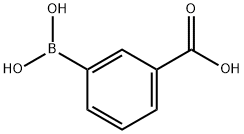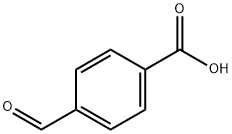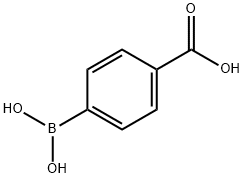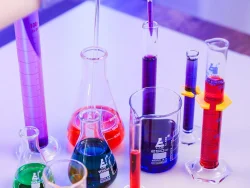3-Carboxyphenylboronic acid
Synonym(s):μ-Carboxyphenylboronic acid;3-(Dihydroxyborane)benzoic acid;3-(Dihydroxyboryl)benzoic acid;3-Boronobenzoic acid;3-Carboxybenzeneboronic acid
- CAS NO.:25487-66-5
- Empirical Formula: C7H7BO4
- Molecular Weight: 165.94
- MDL number: MFCD00036833
- EINECS: 607-734-6
- SAFETY DATA SHEET (SDS)
- Update Date: 2025-07-24 18:13:51

What is 3-Carboxyphenylboronic acid?
Chemical properties
3-Carboxyphenylboronic acid is off-white crystalline powder
The Uses of 3-Carboxyphenylboronic acid
3-Carboxyphenylboronic acid is used in Suzuki coupling chemistry.1,2,3
The Uses of 3-Carboxyphenylboronic acid
suzuki reaction
The Uses of 3-Carboxyphenylboronic acid
3-Carboxyphenylboronic acid can be used as a substrate in the preparation of:
- Biaryl derivatives by reacting with bromoaniline through the Suzuki-Miyaura coupling reaction.
- Boronic acid-functionalized block copolymer.
- 1H-Imidazo[1,2-a]quinoxaline derivatives.
What are the applications of Application
3-Carboxyphenylboronic acid is used in Suzuki coupling chemistry
Properties of 3-Carboxyphenylboronic acid
| Melting point: | 243-247 °C (lit.) |
| Boiling point: | 434.5±47.0 °C(Predicted) |
| Density | 1.40±0.1 g/cm3(Predicted) |
| storage temp. | Keep in dark place,Sealed in dry,Room Temperature |
| solubility | DMSO (Slightly), Methanol (Slightly), Water (Slightly) |
| form | Crystalline Powder |
| pka | 4.21±0.10(Predicted) |
| color | Off-white |
| Water Solubility | 2.5 g/100 mL |
| BRN | 2967400 |
| InChI | InChI=1S/C7H7BO4/c9-7(10)5-2-1-3-6(4-5)8(11)12/h1-4,11-12H,(H,9,10) |
| CAS DataBase Reference | 25487-66-5(CAS DataBase Reference) |
Safety information for 3-Carboxyphenylboronic acid
| Signal word | Warning |
| Pictogram(s) |
 Exclamation Mark Irritant GHS07 |
| GHS Hazard Statements |
H303:Acute toxicity,oral H315:Skin corrosion/irritation H319:Serious eye damage/eye irritation H335:Specific target organ toxicity, single exposure;Respiratory tract irritation |
| Precautionary Statement Codes |
P261:Avoid breathing dust/fume/gas/mist/vapours/spray. P264:Wash hands thoroughly after handling. P264:Wash skin thouroughly after handling. P280:Wear protective gloves/protective clothing/eye protection/face protection. P304+P340:IF INHALED: Remove victim to fresh air and Keep at rest in a position comfortable for breathing. P305+P351+P338:IF IN EYES: Rinse cautiously with water for several minutes. Remove contact lenses, if present and easy to do. Continuerinsing. P405:Store locked up. |
Computed Descriptors for 3-Carboxyphenylboronic acid
| InChIKey | DBVFWZMQJQMJCB-UHFFFAOYSA-N |
| SMILES | C(O)(=O)C1=CC=CC(B(O)O)=C1 |
3-Carboxyphenylboronic acid manufacturer
Sainor Laboratories Pvt Ltd Unit III
1Y
Phone:+91-9182033729
Whatsapp: +91-9666644167
product: 3-Carboxy phenyl Boronic acid 25487-66-5 99%
New Products
4,4-Difluoropiperidine hydrochloride tert-butyl 9-methoxy-3-azaspiro[5.5]undecane-3-carboxylate Indole Methyl Resin N-Isopropylurea N,N-Dicyclohexylcarbodiimide(DCC) MELDRUMS ACID 5-METHYLISOXAZOLE-4-CARBOXYLIC ACID Magnessium Bis glycinate Zinc ascorbate 1-bromo-2-butyne 2-acetamidophenol 9(10H)-anthracenone Erythrosin B, 4-Piperidinopiperidine 2-((4-morpholinophenylamino) (methylthio) methylene) malononitrile 2,4-dihydroxybenzaldehyde 3-(4-morpholinophenylamino)-5-amino-1H-pyrazole-4-carbonitrile Methyl 2-methylquinoline-6-carboxylate 2,6-dichloro-4-nitropyridine 4-Bromo-2-chlorobenzonitrile 2-(benzylamino)acetic acid hydrochloride 4-(tert-Butoxycarbonylamino)but- 2-ynoic acid 3,4-dihydro-2H-benzo[b][1,4]dioxepine 1-Phenyl-1-cycloprppanecarboxylicacidRelated products of tetrahydrofuran








You may like
-
 25487-66-5 98%View Details
25487-66-5 98%View Details
25487-66-5 -
 3-Carboxyphenylboronic acid 99%View Details
3-Carboxyphenylboronic acid 99%View Details
25487-66-5 -
 25487-66-5 99%View Details
25487-66-5 99%View Details
25487-66-5 -
 3-Carboxybenzeneboronic Acid extrapure CAS 25487-66-5View Details
3-Carboxybenzeneboronic Acid extrapure CAS 25487-66-5View Details
25487-66-5 -
 3-Carboxyphenylboronic Acid (contains varying amounts of Anhydride) CAS 25487-66-5View Details
3-Carboxyphenylboronic Acid (contains varying amounts of Anhydride) CAS 25487-66-5View Details
25487-66-5 -
 3-Carboxyphenylboronic acid CAS 25487-66-5View Details
3-Carboxyphenylboronic acid CAS 25487-66-5View Details
25487-66-5 -
 3-CARBOXYBENZENE BORONIC ACID CAS No.: 25487-66-5, Grade: Industrial GradeView Details
3-CARBOXYBENZENE BORONIC ACID CAS No.: 25487-66-5, Grade: Industrial GradeView Details
25487-66-5 -
 25487-66-5 98%View Details
25487-66-5 98%View Details
25487-66-5
Statement: All products displayed on this website are only used for non medical purposes such as industrial applications or scientific research, and cannot be used for clinical diagnosis or treatment of humans or animals. They are not medicinal or edible.
